- How Are White-Label Telemedicine Apps Different from Custom-Built Solutions?
- White-Label Telemedicine App vs. Custom-Built Telemedicine App
- Why Should You Invest in White-Label Telemedicine App Development
- Increased Access
- Enhanced Patient Care
- Unmatched Customization and Flexibility
- Cost Effectiveness
- Improved Convenience
- Competitive Edge
- High Scalability
- Key Features of White-Label Telemedicine Platform Development
- Appointment Scheduling
- Video and Voice Calling
- Calendar Integration
- Notifications and Reminders
- Automated Clinical Notes
- Payment Gateway
- Electronic Health Records
- Multilingual Support
- Administrative Dashboard
- Security and Compliance
- Cloud Storage
- AR for Anatomy Visualization
- AI-Powered Symptom Checker
- Wearable Integration
- White-Label Telemedicine App Development Process
- Market Research and Strategy Formulation
- Compliance and Security Protocols Establishment
- UI/UX, Customization, and Branding Implementation
- Testing, Launch, and Continuous Improvement
- Cost of Building a Telemedicine App
- Future Trends of White-Label Telemedicine Platforms
- Appinventiv's Edge in White-Label Telemedicine Platform Development
- FAQs
The telemedicine industry is witnessing unprecedented growth, with the global market projected to exceed $380 million by 2030, growing at a CAGR of 18.6% from 2023 to 2030. This remarkable market growth reflects the increasing adoption of digital platforms in healthcare.

As healthcare providers and startups rush to adopt this digital transformation, HealthTech companies and medical tech service providers can capitalize on this demand by developing a white-label telemedicine app from scratch.
Unlike off-the-shelf solutions that offer limited flexibility, a custom-built white-label platform allows businesses to retain full control over branding, functionality, and scalability. This enables them to use the app for their operations and license and rebrand it for multiple clients, creating new revenue streams.
By investing in scalable and customizable white-label telemedicine platform development, enterprises can monetize the growing telehealth market, cater to diverse business needs, and gain long-term competitive advantages.
But how do you build a scalable, compliant, and feature-rich platform that meets the evolving demands of modern healthcare? Don’t worry! This blog will illustrate. Here, we will explore the integral steps, key features, and investment required to create a white-label telemedicine platform that engages patients and stands out in the digital healthcare market.
How Are White-Label Telemedicine Apps Different from Custom-Built Solutions?
A white-label telemedicine app is a customizable, brandable telehealth platform that allows businesses to launch virtual healthcare services under their name and branding. Unlike standard telemedicine apps developed for a single organization, white-label solutions are designed to be licensed and adapted by multiple businesses.
While white-label and custom-built telemedicine apps offer unique advantages, they serve different business objectives. The key difference between a white-label telemedicine app and a custom telemedicine platform lies in their development, customization, and deployment approach.
White-Label Telemedicine App vs. Custom-Built Telemedicine App
| Factor | White-Label Telemedicine App | Custom-Built Telemedicine App |
|---|---|---|
| Purpose | Built for scalability and rebranding, allowing multiple businesses to use the same platform. | Designed for a single organization’s specific needs and operations. |
| Time-to-Market | Faster deployment as core features are pre-built and customizable. | Longer development timeline due to end-to-end customization. |
| Flexibility | Customizable branding, features, and integrations for different clients. | Fully tailored to the organization but lacks reusability for others. |
| Revenue Model | It can be monetized by licensing the platform to other healthcare providers. | It can’t be resold to other healthcare providers. |
| Cost Efficiency | More cost-effective as the development cost is spread across multiple clients. | The higher upfront investment for a single-use platform. |
| Maintenance and Updates | Managed centrally with updates applied across all clients. | Requires dedicated maintenance for each implementation. |
Also Read: How Much Does it Cost to Build a White-Label Enterprise Performance Management Software
Why Should You Invest in White-Label Telemedicine App Development
As the healthcare industry rapidly evolves, staying ahead of technology trends is vital. Thus, if you are a healthcare provider looking to establish a strong foothold in the rapidly changing healthcare landscape, integrating a white-label telemedicine app into your business is necessary. Here are some compelling reasons why you should consider investing in a white-label telemedicine platform:
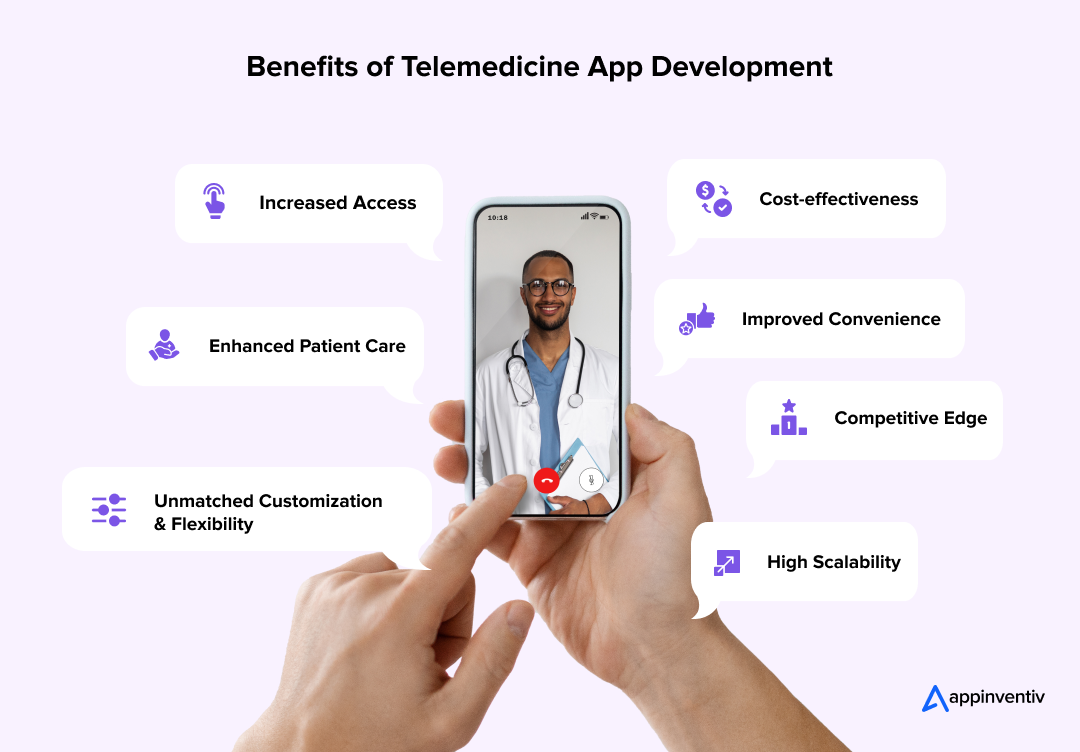
Increased Access
Healthcare mobile apps are transforming the sector by streamlining operations and improving patient access. A white-label telemedicine app significantly broadens patient reach, offering medical services beyond geographical barriers. It facilitates remote consultations, enabling healthcare providers to serve more patients efficiently. This expansion in access not only improves patient care but also enhances the visibility of healthcare brands.
Enhanced Patient Care
With white-label telehealth software development, businesses can focus on patient-centric innovations such as personalized treatment plans, AI-powered chatbots, and real-time health tracking. This leads to better engagement, improved clinical outcomes, and increased trust in digital healthcare services.
Unmatched Customization and Flexibility
The benefits of developing white-label telemedicine platforms lie in their customization and flexibility. White-label telemedicine software development allows enterprises to use the platform exactly to their specifications, integrating unique features, workflows, and customization options tailored for different healthcare providers.
Cost Effectiveness
While the initial investment in a custom white-label telemedicine software development seems significant, it leads to substantial long-term savings by eliminating recurring licensing fees and third-party dependencies. Over time, enterprises can monetize the platform by licensing it to multiple healthcare providers, making the investment highly cost-effective.
Improved Convenience
A white-label telemedicine app or software solution elevates patient care by making health services accessible from anywhere. Patients can schedule visits, consult doctors, and receive prescriptions with just a few clicks. This eliminates the hassle of travel and wait times, significantly enhancing user convenience and satisfaction.
Competitive Edge
Opting for white-label telemedicine platform development makes your app stand out in a crowded market. Offering a robust telemedicine service places your business at the forefront of modern healthcare. It demonstrates a commitment to innovation, improving patient retention, and attracting tech-savvy consumers.
High Scalability
Investing in a white-label telemedicine platform offers scalability for businesses aiming to grow in the digital healthcare space. These platforms are designed with multi-tenancy architecture, ensuring seamless expansion. Enterprises can onboard multiple clients, add new features, and expand to different markets without worrying about platform limitations. It is a strategic move for future-proofing your healthcare services.
Key Features of White-Label Telemedicine Platform Development
Your telemedicine application must possess the critical components and capabilities for operational excellence. These features are foundational to creating a Whitelabel telemedicine platform that delivers an efficient virtual care experience.
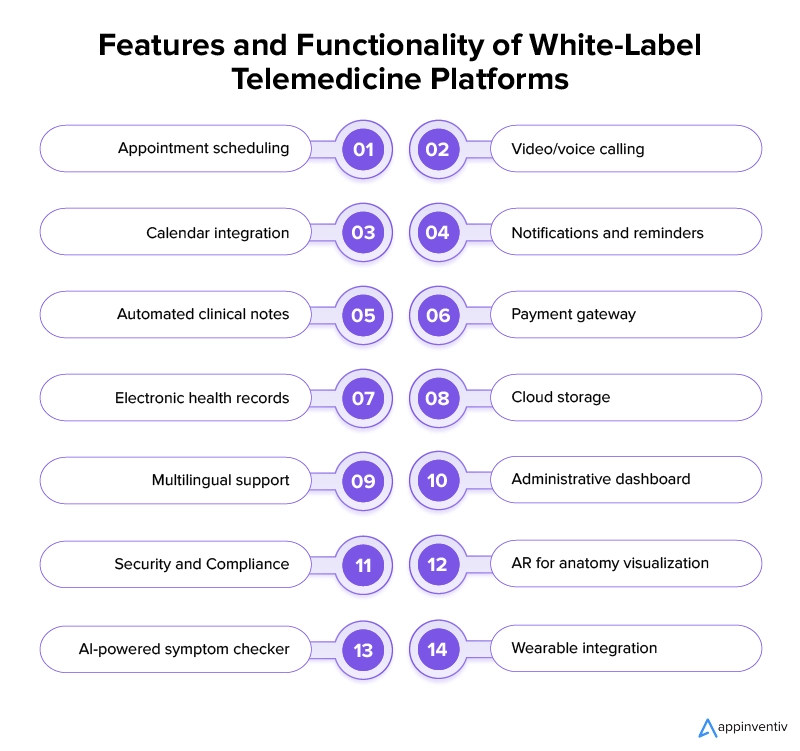
Appointment Scheduling
A white-label telemedicine platform should have a streamlined appointment scheduling feature for convenience. It should enable patients to easily book, reschedule, or cancel appointments, contributing to better time management for both patients and healthcare providers. The telemedicine software solutions must be intuitive and easy to navigate so that the users can quickly view available slots and confirm appointments without hassle.
Video and Voice Calling
High-quality video and/or voice calling is one of the cornerstone features of white-label telemedicine app development. It allows patients to have real-time consultations with healthcare providers, enhancing the care delivery experience. This functionality must be robust and user-friendly, ensuring reliable and streamlined communication across various devices and networks.
Calendar Integration
Effective calendar integration ensures automatic synchronization with personal calendars, enabling timely reminders for upcoming appointments. It is crucial for keeping both patients and healthcare providers organized and punctual. This feature should support multiple calendar formats and provide real-time updates to prevent scheduling conflicts.
Notifications and Reminders
Push notifications and reminders are pivotal features of white-label telemedicine software development, significantly enhancing patient experience. This feature serves as patients’ assistant for health management, alerting them to take medications, attend appointments, or follow up on treatment plans. This proactive feature in the telemedicine software helps maintain treatment continuity and improves health outcomes.
Automated Clinical Notes
Incorporating automated clinical notes is a breakthrough in telemedicine apps and software, streamlining the documentation process for healthcare providers. This feature ensures that every patient interaction is captured accurately and efficiently, which is crucial for quality control and legal compliance adherence. It also facilitates better coordination of care among medical staff.
Payment Gateway
A secure payment gateway integration is necessary for successful white-label telemedicine software development. It processes payments and reinforces patient trust by protecting their sensitive financial data. The payment system must comply with industry standards like PCI DSS to protect sensitive financial information and support seamless billing experiences.
Electronic Health Records
Electronic health records (EHRs) are a foundational element of modern healthcare, providing a comprehensive digital footprint of a patient’s medical history. They enable physicians to track health changes over time, ensure medication accuracy, and share critical information with patients and other healthcare professionals.
Multilingual Support
Multilingual support is a critical functionality that ensures white-label telemedicine software is accessible to a diverse patient demographic. It allows patients from various linguistic backgrounds to use the services conveniently, leading to better patient engagement, satisfaction, and, potentially, improved health outcomes. This support can significantly extend the reach and impact of health services.
Administrative Dashboard
An administrative dashboard is a critical feature for managing the complexities of telehealth services. It provides practitioners and healthcare administrators with powerful scheduling, reporting, and operational oversight tools. A white-label telemedicine platform with a well-designed dashboard streamlines operational processes, reduces administrative burdens and enhances care delivery. It offers a comprehensive view of patient engagements and healthcare services management.
At Appinventiv, we built Health-e-People, a comprehensive health assessment app that centralizes medical data, integrates wearable device insights, finds medical caregivers, and enables seamless doctor-patient collaboration for proactive healthcare management.
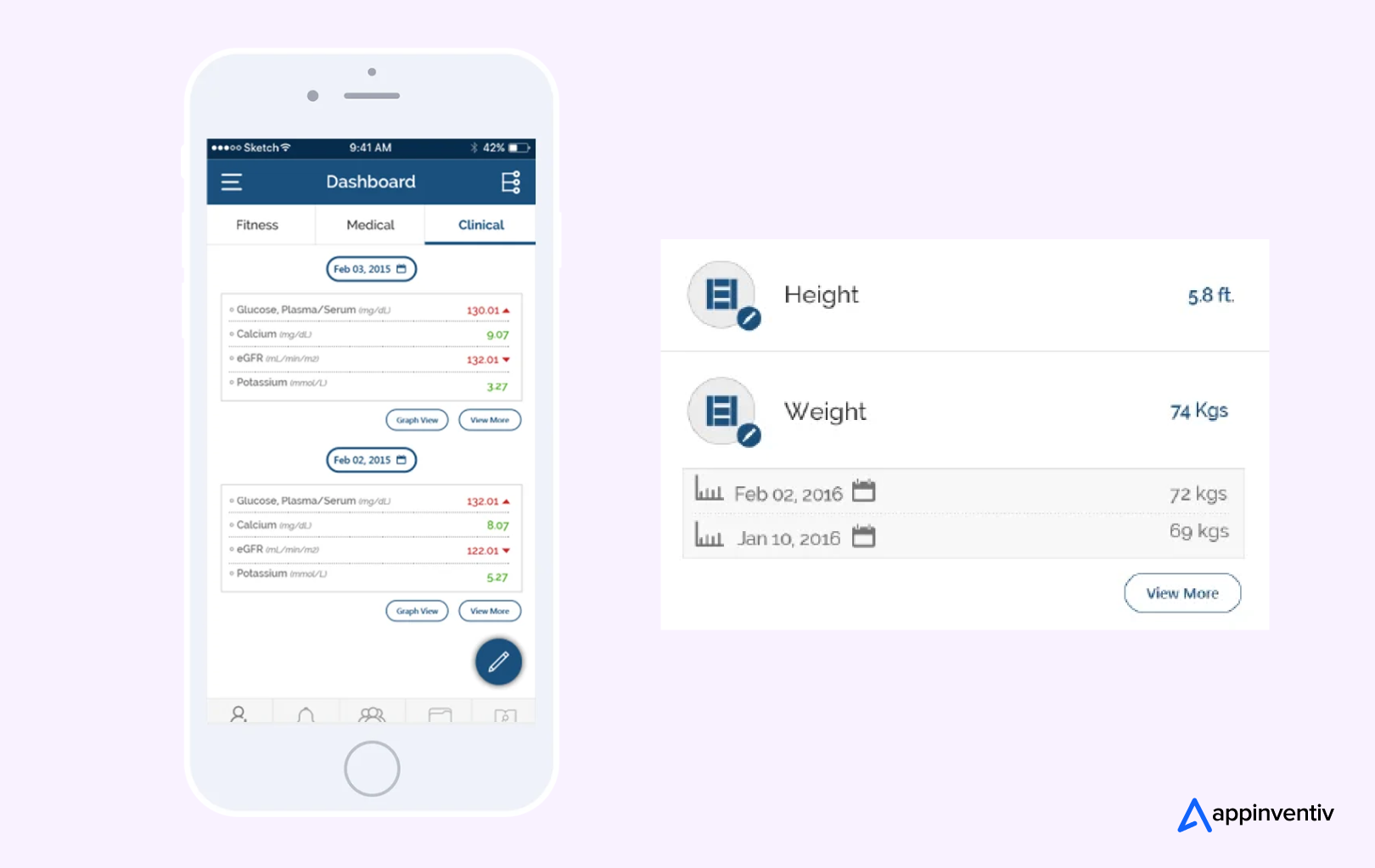
Security and Compliance
Security and compliance are the cornerstone components for white-label telemedicine platform development. Incorporating advanced security protocols and ensuring compliance with healthcare regulations such as HIPAA are non-negotiable features of white-label telemedicine app development. Hippa-compliant telehealth platforms safeguard patient data against breaches and unauthorized access, thus upholding the integrity of telehealth services and reinforcing patient confidence in the digital healthcare system.
Cloud Storage
Reliable cloud storage solutions in telemedicine platforms offer unparalleled benefits, such as real-time data synchronization and remote access to patient information. This feature ensures that patient data is secure from unauthorized access and readily available for medical consultations, a prime necessity for today’s mobile-first world.
AR for Anatomy Visualization
Augmented Reality (AR) for anatomy visualization brings a dynamic edge to telemedicine platforms, allowing patients and physicians to interact with 3D human anatomy models. This technology can transform patient education by providing clear, interactive representations of complex medical conditions and procedures. It enhances the understanding of diagnoses and treatments, making discussions between doctors and patients more engaging and informative.
AI-Powered Symptom Checker
An AI-powered symptom checker is an innovative tool that adds significant value to patient interactions. By analyzing symptoms and providing potential diagnoses, AI in healthcare assists patients in understanding their health conditions before consulting a medical professional. This functionality of AI in telemedicine optimizes the care pathway and maximizes the efficiency of clinical staff, ensuring that the inital patient contact is informative and directing them to the appropriate care level
Wearable Integration
Integrating wearables into telemedicine platforms enables real-time monitoring of vital health metrics. It provides a wealth of data for preventive care and chronic disease management. Patients can share updates on their heart rate, sleep patterns, and activity levels directly with their healthcare providers. This facilitates proactive health management, remote patient monitoring, and personalized care plans based on data collected from their daily lives.
Also read:- Wearable App Development: Applications, Features, Process and More.
These are some of the must-have features of white-label telemedicine platform development. Incorporating them can propel your platform to the forefront of the telemedicine field. They ensure your service is both comprehensive and adaptable to future healthcare innovations.
White-Label Telemedicine App Development Process
Building a white-label telemedicine app from scratch requires a strategic approach to ensure scalability, compliance, and seamless user experience. Each step plays a crucial role, from defining core functionalities to integrating advanced technologies like AI, Blockchain, and IoT in healthcare. A well-structured process for white-label telehealth software development ensures the platform meets regulatory standards while providing a customizable solution for enterprises looking to capitalize on the growing telehealth industry.
Here are the steps essential for building a white-label telemedicine platform
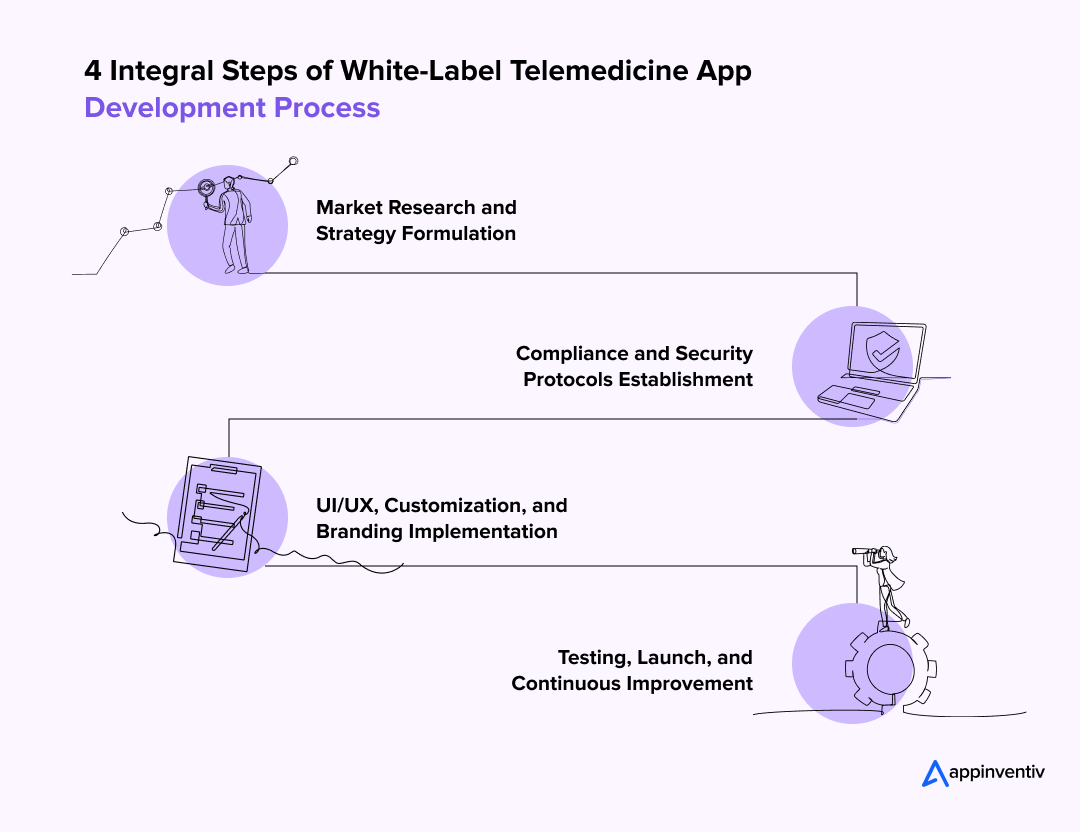
Market Research and Strategy Formulation
Thorough market research and strategic planning are the backbone of successful white-label telemedicine app development. At this stage, you should:
- Analyze target users’ healthcare requirements, competitors’ offerings, emerging trends, and stringent telehealth regulations to identify gaps and opportunities.
- Craft a clear, unique value proposition that differentiates your app in the crowded telemedicine market.
- Outline the essential features and functionality that align with users’ expectations and comply with healthcare standards.
- Strategize on the revenue model, weighing options between subscription services, freemium access, or per-transaction fees.
- Establish a realistic budget and timeline, considering the complexities of development and deployment.
- Set concrete milestones and key performance indicators to measure progress and ensure that your development journey remains on the path to success.
Compliance and Security Protocols Establishment
A white-label telemedicine app must adhere to strict protocols that ensure adherence to HIPAA, GDPR, PHI, and regulatory regulations. At this stage, you should implement essential security measures, including:
- End-to-end data encryption, multi-factor authentication, and biometric access controls to protect sensitive patient data.
- Defined authorization levels and role-based access policies to ensure secure handling of patients’ information
- Secure integration of EHR systems, ensuring seamless data exchange while maintaining integrity and continuity of care.
- Regular security audits, risk assessments, and penetration testing to identify and mitigate potential vulnerabilities.
- Additionally, obtaining necessary telehealth licenses and certifications for compliance in different operational regions is a critical step in the process.
UI/UX, Customization, and Branding Implementation
When embarking on the journey of white-label telehealth platform development, you must ensure that the solution is adaptable for multiple clients while maintaining brand individuality. This involves:
- Crafting an intuitive UI/UX with customizable elements such as color schemes, logos, and layouts to create a seamless branded experience.
- Building modular architecture and configurable features, allowing clients to personalize services based on their healthcare offerings.
- Integrating the solution with existing healthcare systems to support interoperability and a smooth workflow.
- Ensuring a scalable infrastructure that can handle future enhancements and multiple rebrands without disrupting performance.
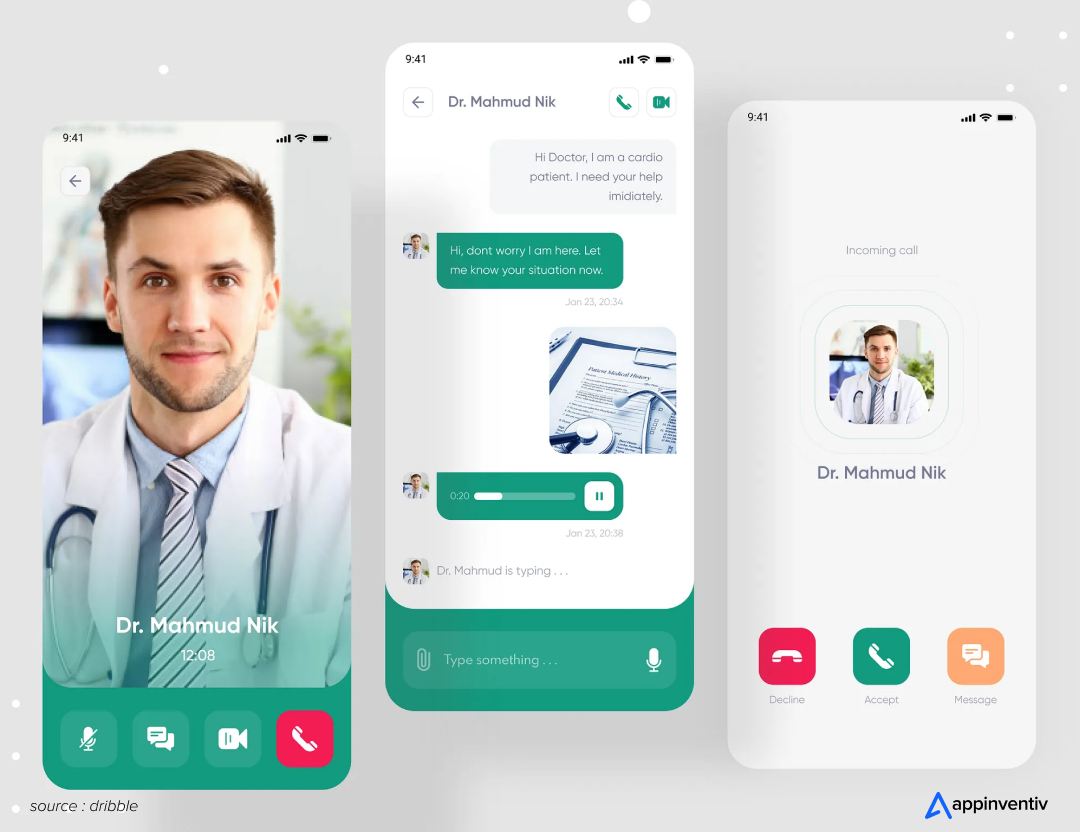
Testing, Launch, and Continuous Improvement
Before the official launch, your telehealth solution undergoes rigorous testing to ensure uninterrupted app performance, reliability, usability, and security. This phase includes:
- Usability and functional testing to ensure a seamless patient-provider experience.
- Load and performance testing to assess platform scalability under high user demand.
- Security compliance testing to confirm adherence to data protection regulations.
- Launching the product and gathering initial user feedback for further refinement.
After the product’s successful launch, the focus shifts to ongoing enhancements and updates to the platform, including feature updates, bug fixes, and adapting to evolving telehealth trends.
Bonus Tip: Partnering with a telemedicine app development company like Appinventiv can further streamline and optimize each phase of the white-label telehealth software development process, ensuring a tailored and successful launch.
Cost of Building a Telemedicine App
There is no pre-defined formula to determine the exact costs to build a white-label telemedicine app from scratch. On average, white-label telemedicine app development costs range between $40,000 to $400,000 or more, depending on several vital factors, such as features, complexity, compliance requirements, tech stack, and developers’ expertise.
For instance, a basic telemedicine app with standard features like appointment scheduling costs you less than a highly complex app with advanced features like video calls or AI diagnostics. Furthermore, developers with niche healthcare expertise often quote higher rates. Yet, their experience can result in a more polished and compliant product.
Third-party integrations, such as payment gateways, AI-powered chatbots, and wearable device connectivity, can also impact costs. Thus, each additional feature should be evaluated for its return on investment potential to maintain a balance between affordability and user-centric functionality.
Here is a table outlining telemedicine white-label app development cost and timeline based on the product’s complexity.
| App Complexity | Average Cost | Average Timeline |
|---|---|---|
| Simple solution with basic features | $40,000-$50,000 | 4-6 months |
| Medium complex platform with Moderate features | $50,000-$150,000 | 4-9 months |
| Highly complex system with advanced features | $150,000-$400,000 or more | 9 months to 1 year or more |
Evaluating the cost of custom white-label telehealth app development is not just about the initial app building cost. Businesses must account for ongoing expenses such as software updates, cloud hosting, security maintenance, and regulatory compliance.
A well-planned budget ensures that the final product efficiently serves both healthcare providers and patients while maintaining long-term sustainability.
Also Read: How much does it cost to build a white-label financial risk management software
Future Trends of White-Label Telemedicine Platforms
The telemedicine industry is growing at an unprecedented pace. According to Statista, online doctor consultation users worldwide surged from 57 million in 2019 to over 116 million in 2024. This upward trend is expected to continue, with users projected to exceed 130 million by 2028.
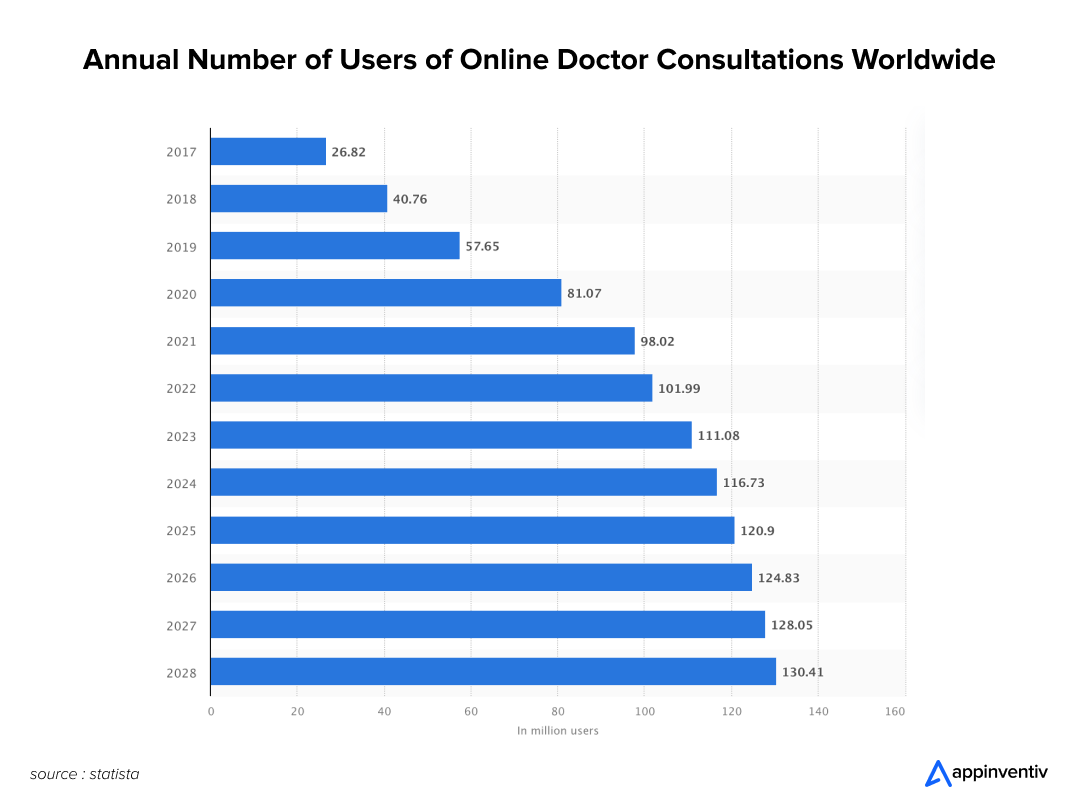
This growth trend in telehealth consultation is fueled by cutting-edge technological advancements and changing patient expectations. Therefore, businesses must understand the future trends of white-label telemedicine platforms to stay ahead in this tech-advanced market.
- Artificial Intelligence: Personalization and AI-powered analytics are the key drivers in enhancing patient experience, enabling predictive health analytics and customized care plans. AI-driven tools enhance medical diagnostics, automate administrative tasks, and improve patient engagement.
- Blockchain: The integration of blockchain in healthcare is another trend. The technology promises to revolutionize data security, ensuring patient privacy and seamless medical record management.
- AR/VR: We can’t overlook the impact of AR and VR in remote diagnostics. Integrating AR and VR in remote diagnostics will redefine virtual consultations, offering immersive and interactive healthcare experiences.
- IoT: Achieving Interoperability and IoT connectivity are becoming focal points for seamless data exchange across multiple devices and platforms. This interconnectivity will improve comprehensive care management.
- 5G: The rise of 5G will further boost telemedicine capabilities by delivering faster connections. Faster connectivity means more reliable and efficient telehealth services, ensuring high-quality video consultations and real-time data transfer.
- Global Expansion: Additionally, as the worldwide adoption of telemedicine expands, the market reach extends beyond local boundaries, creating worldwide healthcare networks. This expansion will necessitate multi-language support and cultural adaptability in apps.
The overarching trend in telemedicine is clear: more accessible, efficient healthcare through advanced technology.
Also Read: Importance of Digital Transformation in Healthcare
Appinventiv’s Edge in White-Label Telemedicine Platform Development
Developing a white-label telemedicine platform from scratch requires deep industry expertise, cutting-edge technology integration, and an in-depth understanding of scalability and compliance. This is where we come in. Appinventiv, a leading healthcare mobile app development company, offers end-to-end white-label telemedicine platform development services tailored to your business needs.
We bridge the gap between healthcare providers and patients by building cutting-edge mobile apps and software solutions. With a focus on intuitive design, stringent security, scalability, and tech-advanced functionality, we ensure that our applications are accessible to users of all ages and can adapt to their evolving demands.
From AI-driven diagnostics, IoT-powered remote monitoring, and blockchain-backed data security to video consultations, we build next-gen healthcare apps that enhance the efficiency of medical services and patient outcomes. Appinventiv’s commitment to excellence doesn’t end at launch. We provide continuous support and maintenance to ensure that your telemedicine services remain at the forefront of innovation.
Our team of 1600+ tech experts understands that every healthcare provider has unique needs. That’s why we offer customizable options to fit various business models.
For instance, we also developed Soniphi, a virtual healthcare app. It’s the first resonant frequency-based personal wellness system that functions as a patient engagement platform providing remote monitoring care plans for all patients.
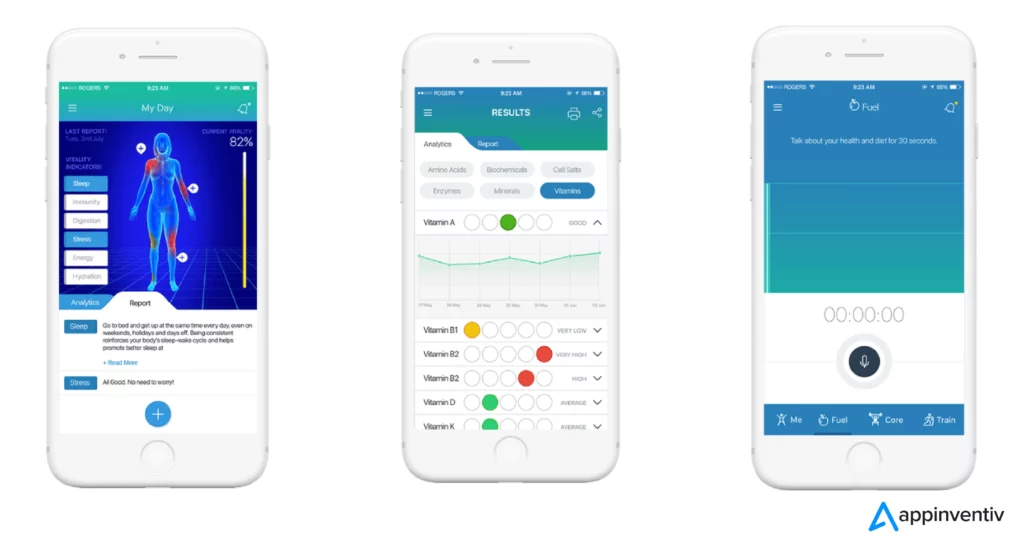
Another head-turning example of our expertise in leveraging technology to build healthcare apps in DiabeticU. Appinventiv developed DiabeticU, a comprehensive diabetes management app that enables real-time health tracking, AI-driven insights, and seamless doctor-patient connectivity for improved care.

We also developed YouCoMM, a custom healthcare mobile app that connects patients with nurses using voice commands and hand gestures. The solution was employed by 5+ hospital chains across the US.
Partner with us to elevate your medical offerings and make a lasting impact in the digital healthcare landscape.
FAQs
Q. What are the key features of a successful telemedicine app?
A. A successful telemedicine app should include features that promote ease of use and accessibility, such as a user-friendly interface for hassle-free navigation. Essential features include secure video conferencing for virtual consultations, real-time messaging for quick communication, and straightforward appointment scheduling systems. Additionally, an integrated payment system is important for processing transactions smoothly, and a robust security protocol is needed to protect patient data.
Q. How long does it take to develop a white-label telemedicine platform?
A. The development timeline for a white-label telemedicine platform can range significantly. Typically, it could take anywhere from 4 months to a year or more. The duration depends on the app’s complexity, the specific needs it aims to address and the expertise of healthcare development company.
Initial stages like design and prototyping are followed by development, testing, and deployment phases, all of which require meticulous attention to detail to ensure a high-quality end product, thus, increases timeline.
Q. What is the cost to develop white-label telemedicine platform?
A. Developing a white-label telemedicine platform can cost between $40,000 and $400,000. This price range depends on several factors, including the app’s features, the level of customization required, chosen tech stack, and the expertise of the development team you partner with.
These critical components significantly contribute to the overall white-label telemedicine platform development cost. Additional costs, such as maintenance and updates, should also be considered for the total investment. Get in touch with our white-label telemedicine software providers to get clear cost estimates for your project.
Q. What are some of the top challenges and solutions of developing white-label telemedicine platform?
A. Here are some of the top implementation challenges of white-label telemedicine app development and solutions to overcome them:
Integration with Existing Systems: Integrating a white-label telemedicine app with existing EHR and practice management systems can be intricate and disruptive.
Solution: Employ robust APIs for integration and collaborate closely with system providers to facilitate smooth data exchange and minimize disruptions.
Compliance with Regulations: Navigating complex healthcare regulations can be challenging and varies by region. Failure to comply can result in legal complications and penalties.
Solution: Consult with a reputed healthcare app development company and legal experts to ensure the app meets all applicable regulations and integrates features that support compliance, including secure data handling and user consent management.
Data Security and Privacy: Safeguarding sensitive patient information from breaches and unauthorized access is crucial.
Solution: Implement advanced encryption, secure data storage practices, and conduct regular security audits. It includes robust authentication and privacy controls in the app.
User Adoption and Training: Facilitating effective use of the app by healthcare providers and patients can be challenging, especially if there is resistance to new technology.
Solution: Offer extensive training and user-friendly resources to ease the transition. Provide continuous customer support to help users navigate the app and resolve any issues.
Q. What are the benefits of developing white-label telemedicine platform?
A. Here are some of the most common benefits of telemedicine white-label app development
- Increased Access
- Enhanced Patient Care
- Unmatched Customization & Flexibility
- Cost-effectiveness
- Improved Convenience
- Competitive Edge
- High Scalability
To gain an in-depth understanding of these benefits of telemedicine white-label app development, please refer to the above blog.


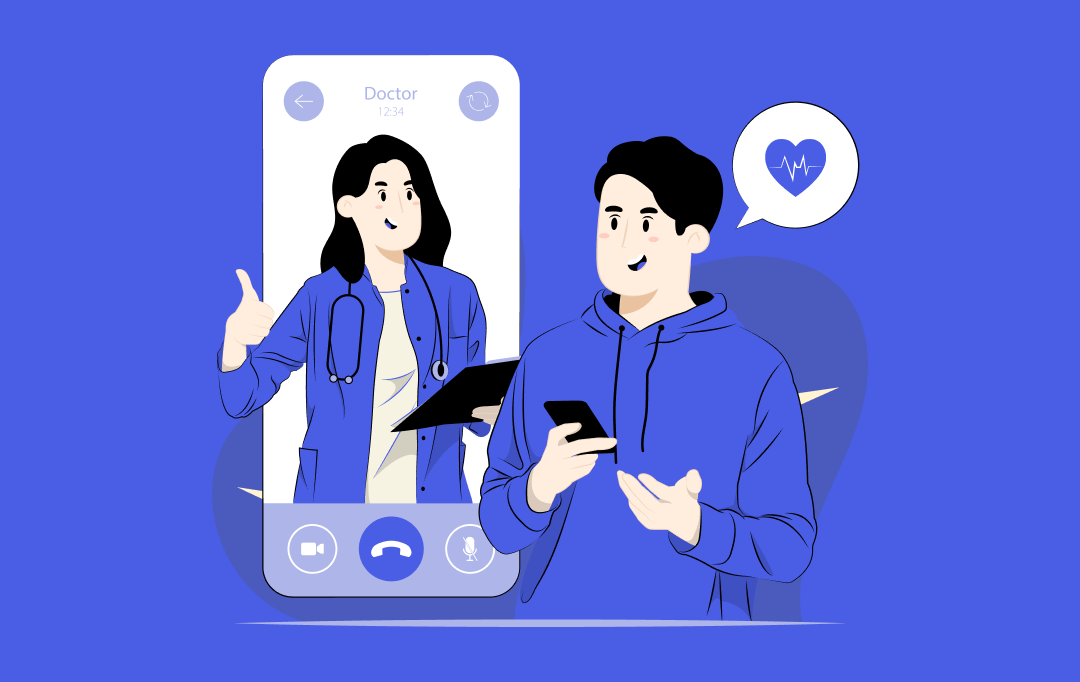
Why Telehealth Security is Non-Negotiable for Patient Trust and How to Achieve It
Key takeaways: Telehealth security is crucial for patient trust and the continued adoption of digital healthcare services. The rising tide of cyber threats, from ransomware to inadequate authentication, poses significant risks to patient data and provider reputation. Implementing robust security measures like end-to-end encryption, multi-factor authentication, and regular audits is non-negotiable. Compliance with regulations like…

10 Ways Healthcare Providers Are Using Patient Analytics to Enhance Care Plans and Optimize Outcomes
Imagine a world where doctors don’t just react to health crises, but predict and prevent them before they happen. This is the reality with patient analytics for healthcare providers. The healthcare industry is no longer limited to treating symptoms—it’s now about understanding patterns, making smarter decisions, and delivering care that’s truly personalized. And it’s not…

Exploring the Role of Personalization in Healthcare through Technology
Key takeaways: Personalization in healthcare transforms patient care from generic, population-based treatments to individualized approaches tailored to each patient's unique needs. Advanced technologies like AI, IoMT, and genomics are the core enablers for tailoring medical treatments. Personalization drives significant benefits, including improved patient outcomes, higher engagement, and reduced costs. The future of healthcare is hyper-individualized,…

















